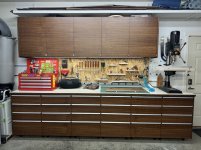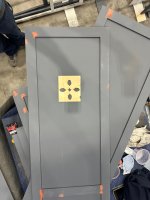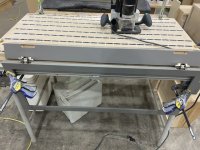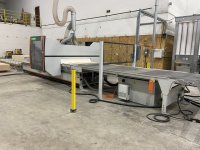tjbnwi said:
[member=58857]Crazyraceguy[/member]
At my shops altitude the machine has 3 vacuum pumps with the third having twice the capacity of the 2 on board pumps combined. We still have to use onion skins and tabs to keep parts from flying around the shop.
I’ve been considering going to diamond bits with heat shrink holders. Mind asking if the operators think they’re worth the added expense? I do send the carbides out to be sharpened.
Tom
Yeah, Tom I can imagine that loss of pressure is a huge factor. I'm not saying we don't lose a part now and then, but not often, especially on the main machine where it is cutting Melamine or pre-laimnated panels. They are stable. It's the plywood that I use for reception desk parts that is the biggest source of moved parts. You can place a perfectly flat sheet down and once it starts cutting, release some tension, and things warp. Long skinny parts, too near the front edge, are the most common. Also (as I'm sure you know, but others may not) as the program runs and more material is removed the pumps are now experiencing a vacuum loss through the gaps between parts. It's easy to suck down a whole 4' x 8' sheet, but cut it up with a 3/8 diameter bit, at a violent speed and see what happens. Well, most of the time , nothing dramatic, you just have to collect the parts and start the next sheet [big grin]
Once in a while though, it will push one, right off on the floor. Hopefully, it's to the back, so the laser safety shield doesn't see it. Sometimes they do onionskin some smaller parts, but then
I have to deal with cutting them apart and flush-trimming. We have been talking about going with tabs as an easier to post-process alternative, but it hasn't happened yet. It's not a big enough issue to get immediate attention.
The diamond bits are fantastic. They will outlast your regular stuff by a mile. There is one huge caution with them though. They are very brittle at the edges. You absolutely cannot measure the diameter with calipers. You can't touch those things with anything harder than wood. It sounds silly, because it will plow though partical board, plywood, solid surface, HPL, at break-neck speed, but calipers will kill it in 1 second flat. Our main operator learned that the hard way.
twice [eek]
The only thing I would question is the heat-shrink holders. They are great, don't get me wrong, but there's a thing to work out with your sharpener/supplier, and that is removing/replacing the bit. They charge you for that, of course, but it depends on how much and how often you need to do it.
The bosses looked into getting the heater thing to do it in-house, but so far have elected to stay with letting the service do it.
We send all of the other bits out for sharpening too (carbide) It's only the primary cut-out bit that is diamond. The ones for grooving backs, etc. are normal carbide.
We switched some of the production away from the CNC though. Now that there are a couple of guys who have been trained well enough to do it, they don't waste CNC time on cabinet backs anymore. All of those get done on the Beam Saw.
Do you guys use dowels for carcass construction?
For people who have never seen anything like this, it's so odd to watch this machine go out in the middle of nowhere and start drilling holes. They look like nothing you would recognize, then it comes back with another bit and starts cutting grooves, again looking dis-jointed. When it gets the big bit and starts cutting out the panels, it all makes sense, but that's the last operation.





